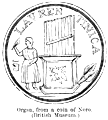Hydraulus
(
ὕδραυλος). A water-organ. According to Athenaeus, it was
the invention of Ctesibius of
Alexandria (q.v.),
who evidently took the idea of his organ from the syrinx or Pandean pipes, a musical
instrument of the highest antiquity among the Greeks. His object being to employ a row of
pipes of great size, and capable of emitting the most powerful as well as the softest sounds,
he contrived the means of adapting keys with levers (
ἀγκωνίσκοι), and with perforated sliders (
πώματα) to open and shut the mouths of the pipes (
γλωσσόκομα), a supply of wind being obtained, without intermission, by bellows,
in which the pressure of water performed the same part which is fulfilled in the modern organ
by a weight (Hero ,
Spirit. 228). On this account the instrument invented by
Ctesibius was called the water-organ (
ὕδραυλις, ὑδραυλικὸν
ὄργανον, Heron,
Spirit.; hydraulica machina, Vitruv. x. 13;
hydraulus, Pliny ,
Pliny H. N. ix.
24;
Cic. Tusc. iii. 18.43). It is
described in an epigram by the emperor Julian (Brunck,
Anal. ii. 403 =
Anth. Pal. ix. 365), who mentions the
swift fingers of the performer, but not the water-bellows; and more clearly in the lines of
Claudian (
De Manl. Theod. Cons. 316-319). We have here the keys, the
innumerable pipes of metal, the lever as large as a beam which sets the water in motion. Its
pipes were partly of bronze (
χαλκειὴ ἄρουρα, Julian ;
seges aëna, Claudian), and partly of reed (
δόνακες, Julian ). The number of its stops, and consequently of its rows of pipes, varied from one to eight, so that Tertullian (
De Anima,
14) describes it with reason as an exceedingly complicated instrument. We are still in the
dark as to the exact part played by the water, which, besides, must have rendered the
instrument much less portable. As invented by Ctesibius, the organ was doubtless hydraulic:
but the epigram of Julian omits all mention of the water, and probably, in later times, the
mechanism was simplified and the bellows blown directly by the pedal, as in the modern
harmonium.
The organ was well adapted to gratify the Roman people in the splendid entertainments
provided for them by the emperors and other opulent persons. Nero was very curious about
organs, both in regard to their musical effect and their
 |
|
Organ, from a coin of Nero. (British Museum.)
|
mechanism (
Suet. Ner. 41, 54). A
contorniate coin of this emperor in the British Museum (see illustration) shows a small organ
with a sprig of laurel on one side and a man standing on the other. The general form of the
organ is also clearly exhibited in a poem by Publilius Porphyrius Optatianus, describing the
instrument, and composed of verses so constructed as to show both the lower part which
contained the bellows, the wind-chest which lay upon it, and over this the row of twenty-six
pipes. These are represented by twenty-six lines, which increase in length each by one letter,
until the last line is twice as long as the first (Wernsdorf,
Poetae Lat. Min.
vol. ii. pp. 394-413).
There can be little doubt that
ὑδραύλης,
hydraula or
hydraules, denotes the organist (
Suet. Ner. 54;
Sat. 36). See
Musica.





